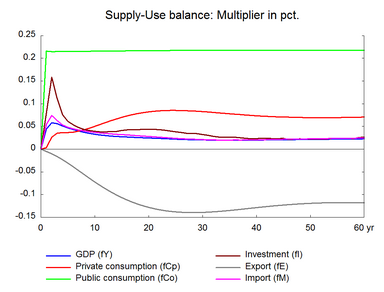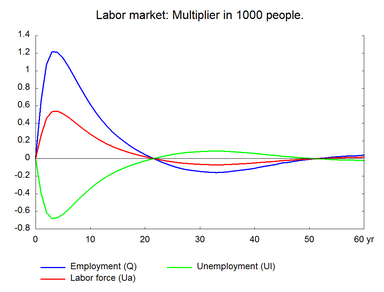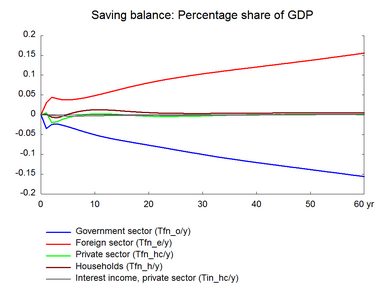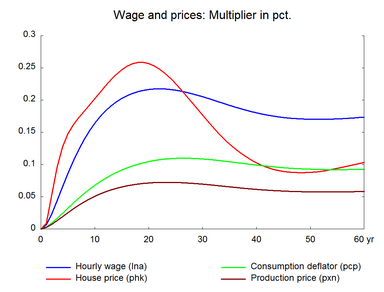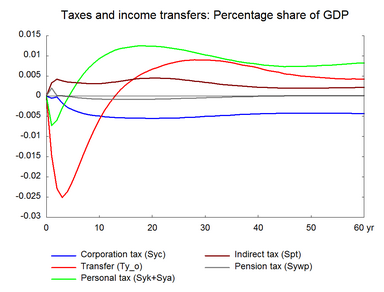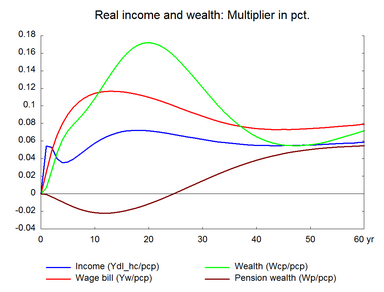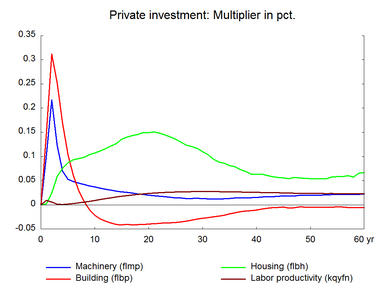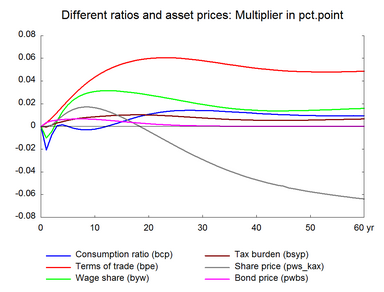More government purchase increases the demand for private produced products and services. Consequently, private employment rises in the short run. Table 1 presents the effect of a permanent increase in general government purchase of goods and services. The public expenditure is increased permanently by about 0.1 per cent relative to the baseline. The increase corresponds to 1000 million kroner in the first year of the experiment in 2005 prices. (See experiment)
Table 1. The effect of a permanent increase in general government spending
| 1. yr | 2. yr | 3. yr | 4. yr | 5. yr | 10. yr | 15. yr | 20. yr | 25. yr | 30. yr | ||
| Million 2005-kr. | |||||||||||
| Priv. consumption | fCp | 27 | 221 | 298 | 314 | 320 | 474 | 712 | 899 | 1005 | 1050 |
| Pub. consumption | fCo | 892 | 901 | 915 | 930 | 944 | 1020 | 1102 | 1190 | 1285 | 1386 |
| Investment | fI | 270 | 531 | 390 | 272 | 224 | 156 | 177 | 202 | 191 | 174 |
| Export | fE | -45 | -91 | -149 | -216 | -291 | -738 | -1173 | -1520 | -1765 | -1917 |
| Import | fM | 469 | 655 | 572 | 494 | 454 | 378 | 354 | 333 | 305 | 291 |
| GDP | fY | 710 | 938 | 919 | 847 | 787 | 594 | 534 | 518 | 499 | 496 |
| 1000 Persons | |||||||||||
| Employment | Q | 0.66 | 1.07 | 1.22 | 1.21 | 1.14 | 0.62 | 0.25 | 0.05 | -0.08 | -0.15 |
| Unemployment | Ul | -0.39 | -0.61 | -0.68 | -0.67 | -0.63 | -0.34 | -0.14 | -0.02 | 0.05 | 0.08 |
| Percent of GDP | |||||||||||
| Pub. budget balance | Tfn_o/Y | -0.03 | -0.02 | -0.02 | -0.03 | -0.03 | -0.05 | -0.07 | -0.08 | -0.09 | -0.10 |
| Priv. saving surplus | Tfn_hc/Y | 0.00 | -0.02 | -0.02 | -0.01 | -0.01 | 0.00 | 0.00 | 0.00 | 0.00 | 0.00 |
| Balance of payments | Enl/Y | -0.03 | -0.04 | -0.04 | -0.04 | -0.04 | -0.05 | -0.07 | -0.08 | -0.09 | -0.10 |
| Foreign receivables | Wnnb_e/Y | -0.06 | -0.12 | -0.17 | -0.21 | -0.24 | -0.43 | -0.64 | -0.90 | -1.17 | -1.44 |
| Bond debt | Wbd_os_z/Y | 0.02 | 0.03 | 0.05 | 0.07 | 0.09 | 0.26 | 0.48 | 0.72 | 0.98 | 1.25 |
| Percent | |||||||||||
| Capital intensity | fKn/fX | -0.07 | -0.07 | -0.06 | -0.05 | -0.04 | -0.02 | 0.00 | 0.01 | 0.01 | 0.02 |
| Labour intensity | hq/fX | -0.05 | -0.04 | -0.04 | -0.03 | -0.03 | -0.03 | -0.03 | -0.03 | -0.03 | -0.03 |
| User cost | uim | 0.00 | 0.01 | 0.02 | 0.03 | 0.03 | 0.06 | 0.07 | 0.08 | 0.08 | 0.08 |
| Wage | lna | 0.01 | 0.02 | 0.04 | 0.07 | 0.09 | 0.16 | 0.20 | 0.22 | 0.22 | 0.21 |
| Consumption price | pcp | 0.00 | 0.01 | 0.02 | 0.02 | 0.03 | 0.07 | 0.09 | 0.10 | 0.11 | 0.11 |
| Terms of trade | bpe | 0.00 | 0.01 | 0.01 | 0.02 | 0.02 | 0.04 | 0.05 | 0.06 | 0.06 | 0.06 |
| Percentage-point | |||||||||||
| Consumption ratio | bcp | -0.02 | -0.01 | 0.00 | 0.00 | 0.00 | 0.00 | 0.00 | 0.01 | 0.01 | 0.01 |
| Wage ratio | byw | -0.01 | 0.00 | 0.00 | 0.01 | 0.02 | 0.03 | 0.03 | 0.03 | 0.02 | 0.02 |
The immediate effect of an increase in government purchase of goods and services is that total demand rises. The increased demand is met partly through domestic production and partly through imports. The expansion in domestic economic activity raises private sector employment and lowers unemployment. The lower unemployment rate pushes prices and wages upward and reduces competitiveness. The lower competitiveness makes the market share of exports fall and the market share of imports rise, which reduces the positive effect on domestic production. Eventually, the effect on employment disappears and returns to the baseline. The long run effect on unemployment is zero reflecting a permanent rise in wages and prices, and therefore a permanent fall in competitiveness.
The multiplier effects can be related to the Keynesian income multiplier. The income multiplier refers to the final change in income arising from an initial change in income, such as in the case of more government spending. The final change in income is larger than the initial change in spending. This is because the initial increase in income creates additional private demand and leads to more income, which in turn creates more spending and more demand, and so on. In this case, the income multiplier can be seen as the ratio between the effect on GDP and the change in government purchase of goods and services. In a closed economy, the multiplier for domestic demand is larger than one because the exogenous increase in government purchase of goods and services creates additional domestic demand in the form of more private investment and larger private consumption. The ADAM multiplier for GDP is less than one because higher demand triggers not only GDP but also imports, see also ADAM book for further discussion.
Wages and prices increase in the medium and long run. But not equally. Prices adjust gradually to total production cost. But production costs include other than wages. Imported goods and services are for instance part of production cost. As the prices of imported goods are unchanged, prices increase less than wages. This results in a permanent positive effect on real wage, real income and private consumption. The long term macro-consumption function in ADAM relates consumption to income and wealth and ensures that private consumption, real income and real wealth grow relatively by the same amount in the long run. Whenever real wages and real disposable income change permanently, private consumption changes. Increased public spending creates a permanent positive real wage effect. Thus the composition of GDP changes permanently towards higher public and private consumption and lower net exports relative to the baseline.
The real wage effect also translates into a long run effect on terms of trade. The positive change in real wage increases domestic demand and reduces foreign demand. In the new equilibrium employment returns to the baseline and wages and prices increase permanently, which results in a permanent change in the long run terms of trade.
The consumption equation stabilizes the saving surplus of the private sector in the long run. Thus the private sector saving surplus returns to the baseline. In contrast, the government budget balance and the balance of payments become negative in the long run. This reflects the absence of an automatic fiscal reaction.
Figure 1. The effect of a permanent increase in general government spending
